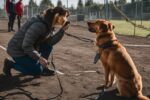Mastering Obedience: Essential Dog Training Techniques

Welcome to our comprehensive guide on Basic Dog Training Techniques for puppy training. Understanding canine behavior is key to establishing a well-behaved pet. By implementing these techniques, you can shape your furry friend’s behavior and ensure long-term obedience. Let’s dive into the world of canine behavior and explore the essential techniques that will help you train your dog effectively.
Before we delve into the nitty-gritty of training techniques, it’s important to grasp the fundamentals of canine behavior. Dogs have unique instincts and communication methods that require careful observation and understanding. By learning their body language, socialization needs, and pack hierarchy, you can tailor your training approach to suit your dog’s specific requirements.
In the following sections, we will outline the most important Basic Dog Training Techniques that every owner should incorporate into their training routine. These techniques will help you establish clear communication and build a strong bond with your furry companion. From teaching essential commands like sit and stay to ensuring proper recall and loose leash walking, we have got you covered. Let’s get started!
Understanding Canine Behavior
Understanding canine behavior is vital for effective dog training. Dogs have their unique instincts and ways of communication, and having a grasp of these behaviors is essential for shaping their behavior through training techniques. By observing your dog’s body language, responses, and socialization patterns, you can tailor your training approach to meet their specific needs.
Canine behavior encompasses various aspects, including body language, socialization, and pack hierarchy. By understanding and interpreting your dog’s body language, such as tail wagging, ear positioning, and eye contact, you can better communicate and respond to their needs. Socialization is also crucial, as it helps dogs develop appropriate behavior around people, other animals, and different environments. Recognizing the concept of pack hierarchy can guide you in establishing your role as the leader and fostering obedience within your dog.
Body Language
Recognizing and interpreting your dog’s body language is key to understanding their emotional state and needs. For example, a wagging tail may indicate happiness or excitement, while a tucked tail can signal fear or anxiety. Additionally, paying attention to ear position, eye contact, and overall posture can provide valuable insights into your dog’s current mood and intentions.
Socialization
Socialization plays a significant role in a dog’s behavior and overall temperament. By exposing your dog to different people, animals, and environments from an early age, you can help them develop positive associations and adaptability. Gradually introducing your dog to new experiences, such as walks in the park or interactions with other dogs, will promote confidence and reduce the likelihood of fear-based behaviors.
Pack Hierarchy
In a dog’s natural instincts, pack hierarchy determines the order of leadership and obedience. Establishing yourself as the leader and consistently reinforcing this hierarchy will help your dog understand their place and maintain obedience. This can be achieved through consistent training, clear commands, and maintaining structure and routine in their daily lives.
By incorporating an understanding of canine behavior into your basic dog training techniques, you can optimize the effectiveness of your training sessions and foster a well-behaved and obedient pet.
Essential Basic Dog Training Techniques
When it comes to training your dog, incorporating essential Basic Dog Training Techniques is crucial for achieving obedience and a well-behaved pet. These techniques focus on establishing clear communication and building a strong bond between you and your furry friend.
One foundational technique is teaching your dog the “sit” command. This not only helps establish control but also prevents jumping. The “stay” command is another essential technique that keeps your dog in one place and prevents them from wandering off or getting into potential dangers.
Recall or the “come” command is particularly important in emergency situations or when your dog is off-leash. Training your dog to walk calmly on a leash without pulling, known as loose leash walking, is not only for their safety but also for your enjoyment during walks together.
Lastly, the “leave it” and “drop it” commands are critical for teaching your dog to release or avoid items that may be dangerous or inappropriate, such as food or harmful objects. By consistently practicing these Basic Dog Training Techniques, you will establish a well-behaved and obedient dog.
FAQ
What are some basic dog training techniques?
Some basic dog training techniques include teaching commands like sit, stay, recall (come), loose leash walking, and leave it/drop it.
Why is understanding canine behavior important for training?
Understanding canine behavior is important for successful training as it helps tailor the training approach to address the dog’s specific needs, based on their behavior, body language, and responses.
How do I teach my dog the “sit” command?
To teach your dog the “sit” command, hold a treat close to their nose and raise it slowly, causing their head to follow the treat and their bottom to lower. Once they are in the sitting position, say “sit” and reward them with the treat.
Why is the “stay” command important?
The “stay” command is crucial for keeping your dog in one place and prevents them from wandering off or getting into potential dangers.
How can I train my dog to come when called?
To train your dog to come when called, start in a calm environment and say their name followed by the command “come.” Use a happy and encouraging tone of voice and reward them with praise or treats when they come to you.
What is loose leash walking and how can I train my dog to do it?
Loose leash walking means your dog walks calmly on a leash without pulling. To train your dog for this, start by rewarding them for walking calmly beside you, and gradually increase the duration and distractions during the walks.
What does “leave it” and “drop it” mean?
“Leave it” and “drop it” are commands that teach your dog to release or avoid items that may be dangerous or inappropriate for them, such as food or harmful objects.
How often should I practice these basic dog training techniques?
Consistency is key in dog training. Aim to practice these basic training techniques daily, starting with short sessions and gradually increasing the duration over time.
How long does it take for a dog to learn basic training commands?
The time it takes for a dog to learn basic training commands can vary depending on the individual dog and the consistency of training. With daily practice and positive reinforcement, dogs can usually learn basic commands within a few weeks to a few months.
Can I train an older dog with these basic techniques?
Yes, older dogs can still learn and benefit from basic training techniques. They might require additional patience and consistency, but with the right approach, it is possible to teach them obedience and new commands.






